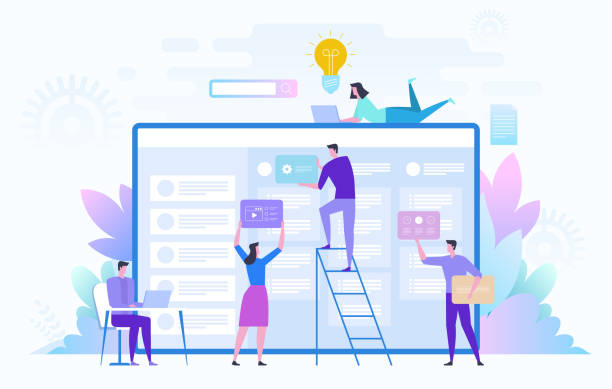Introduction to E-commerce Website Design and its Importance in the Digital Age
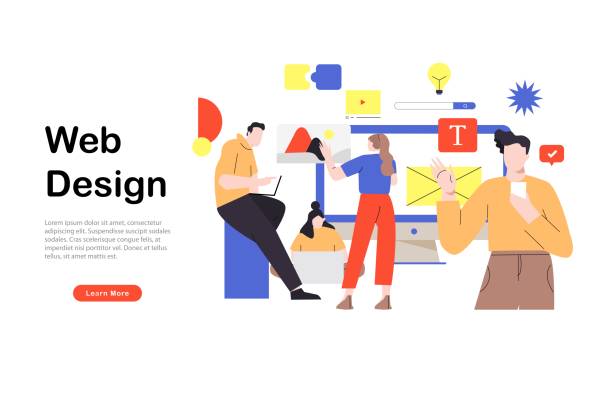
In today’s world, where geographical boundaries in commerce have faded, e-commerce has become the backbone of the global economy.
#E-commerce_website_design is no longer a luxury option, but a necessity for the survival and growth of any business, whether small or large.
An efficient online store not only displays your products to millions of people but also provides the possibility of selling without time and location restrictions.
This section offers a descriptive and guiding comprehensive view on the importance and position of e-commerce website design in the digital business ecosystem.
Creating a strong online sales platform requires a deep understanding of market needs, customer behavior, and up-to-date technologies.
The main goal of e-commerce website design is to convert visitors into loyal customers.
This process includes optimizing user experience (UX), site loading speed, payment security, and easy access to product information.
Success in this field depends on meticulous planning and flawless execution.
We will continue to examine the key elements that distinguish an e-commerce site from its competitors and explain educational and practical tips for you to start a confident path in this field.
The importance of having a powerful online presence not only leads to increased sales but also strengthens your brand’s credibility in today’s competitive market.
Are you tired of having visitors to your e-commerce site but no sales? Rasawweb solves your main problem with professional e-commerce website design!
✅ Significant increase in sales with targeted design
✅ Flawless user experience for your customers
⚡ Get a free consultation!
Key Features of a Successful Online Store
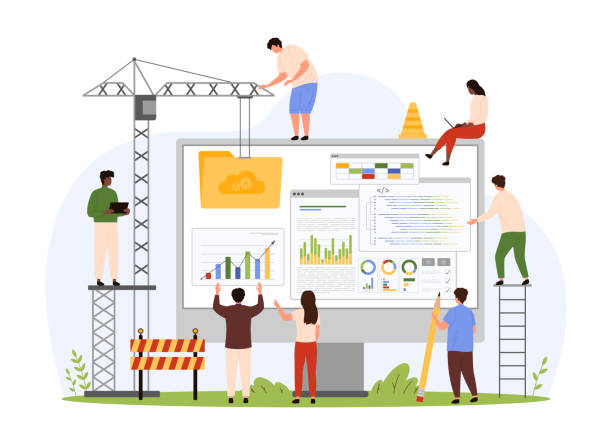
A #successful_e-commerce_site goes beyond displaying products; it must provide a #smooth and #engaging_user_experience to encourage customers to buy.
Crucial features include a visual and user-friendly user interface (UI), easy navigation, high page loading speed, and responsive design, which allows access via various devices.
This section offers a specialized and guiding perspective on the technical and visual features required for an ideal e-commerce site.
In addition, a strong Content Management System (CMS) that allows easy updating of products, prices, and inventory is very important.
Advanced filtering and search capabilities, high-quality images, comprehensive product descriptions, and customer reviews all help increase customer trust and decision-making.
Secure and diverse payment gateways, order management systems, and parcel tracking capabilities are also vital pillars that improve the shopping experience.
E-commerce website design should be such that it provides all these features seamlessly and flawlessly.
Also, the importance of Search Engine Optimization (SEO) should not be overlooked so that your site is visible in search results and attracts organic traffic.
Choosing the Right Platform for Your E-commerce Website Design
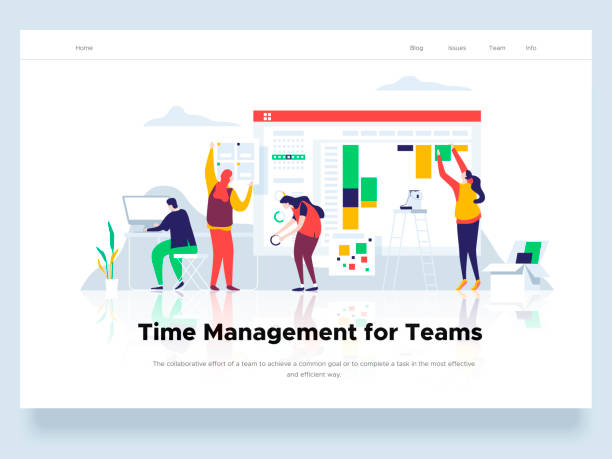
Choosing the right #e-commerce_platform is a very important step in the #online_store_creation process that can significantly impact the future success of your business.
Numerous options exist, including WooCommerce for WordPress, Shopify, Magento, and proprietary platforms, each with its own advantages and disadvantages.
This section provides an analytical and educational review on platform selection.
The decision regarding the platform should be based on factors such as budget, your team’s technical skills, required scalability, and your business’s specific features.
WooCommerce is ideal for small to medium-sized businesses looking for flexibility and full control, while Shopify offers a simple and fast solution for launching a store with minimal technical knowledge.
Magento is suitable for large companies with complex needs.
E-commerce website design with the correct platform provides a strong foundation for future growth.
Table 1: Comparison of Popular E-commerce Website Design Platforms
| Feature | WooCommerce (WordPress) | Shopify | Magento |
|---|---|---|---|
| Ease of Use | Medium (requires WordPress knowledge) | Very High | Low (requires high technical knowledge) |
| Scalability | High (with suitable hosting) | Very High | Very High (suitable for large companies) |
| Control and Flexibility | Very High (open-source) | Medium (service-dependent) | Very High (open-source) |
| Cost | Variable (hosting, theme, plugins) | Monthly (various plans) | High (implementation, maintenance) |
| Support | Community, developers | Official and comprehensive | Community, official partners |
The Importance of User Experience (UX) and User Interface (UI) in E-commerce Website Design
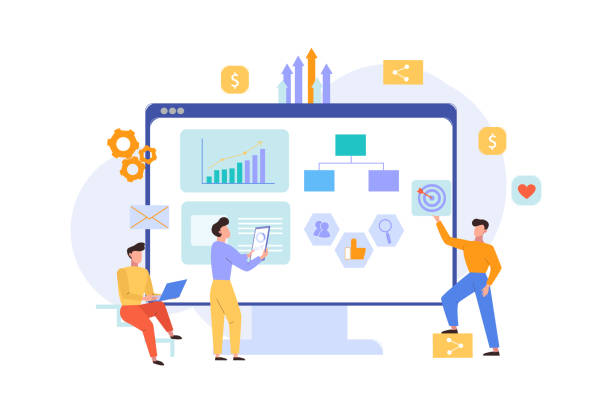
#User_experience and #user_interface are two critical factors in #e-commerce_site_success that are often confused with each other, but both play complementary roles in attracting and retaining customers.
UI (User Interface) refers to the visual appearance and interactions of a site, while UX (User Experience) refers to the user’s overall feeling when interacting with the site.
This section provides a specialized and descriptive perspective on this.
An attractive UI and a flawless UX can make the difference between an ordinary online store and a leading store.
Clean visual design, readable fonts, appropriate color schemes, and clear calls to action (CTAs) all contribute to a strong UI.
On the other hand, UX includes loading speed, intuitive navigation, an easy purchasing process, and a minimum number of clicks to reach a goal.
The more positive the user experience, the higher the likelihood of their return and completing the purchase process.
Therefore, in e-commerce website design, investing in these two aspects is of high importance.
Reviewing user feedback and conducting A/B tests can also help continuously improve UI/UX and answer questionable content regarding design effectiveness.
Do you have an e-commerce site but your sales are not as expected? Rasawweb solves your problem forever with professional e-commerce website design!
✅ Significant increase in conversion rate and sales
✅ Unparalleled user experience for your customers
⚡ Click here to get a free consultation with Rasawweb!
How SEO for Online Stores Attracts More Traffic?
![]()
Search Engine Optimization (SEO) is an essential component for #online_visibility and #increasing_sales on an #e-commerce_site.
Without strong SEO, even the best products and design may get lost in the vast world of the internet.
SEO includes a set of techniques that help search engines like Google better understand your site’s content and display it higher in search results to users.
This section provides an educational and analytical guide on SEO strategies for online stores.
Key SEO actions for an online store include targeted keyword research for products and categories, optimizing titles and meta descriptions, creating high-quality and unique content for product pages, using optimized images, and building authoritative backlinks.
Site speed is also an important SEO factor that affects both user experience and ranking.
Proper implementation of these principles in the e-commerce website design process not only attracts more organic traffic but also increases your brand’s credibility and trust.
News and up-to-date content about changes in Google’s algorithms are also essential for maintaining site rankings.
The Importance of Secure Payment Gateways and Order Management Systems
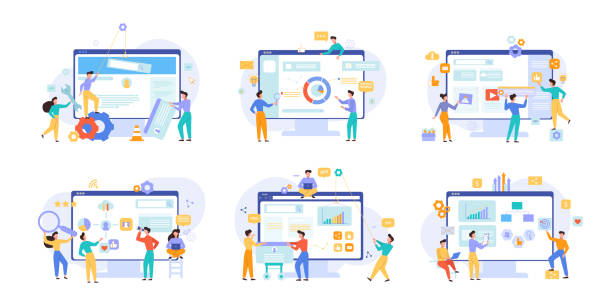
In an #online_store, the security of #financial_transactions and the efficiency of #order_management are among the most important factors in building customer trust and maintaining smooth business operations.
Choosing and implementing secure and reputable payment gateways assures customers that their financial information is protected, while a strong order management system optimizes the sales process from purchase to delivery.
This section provides a specialized and descriptive perspective in this regard.
To ensure security, using the HTTPS protocol and an SSL certificate is essential.
Integration with popular and reliable payment gateways in your region (such as local banks or Shaparak network in Iran) helps increase customer ease and trust.
The order management system should also include features such as inventory tracking, order status updates, sending notifications to customers, and integration with shipping systems.
E-commerce website design that effectively integrates these elements provides a hassle-free shopping experience for customers and, on the other hand, makes business operations more efficient.
These aspects are crucial to prevent questionable content regarding security.
Marketing and Advertising Strategies to Increase Sales in Online Stores
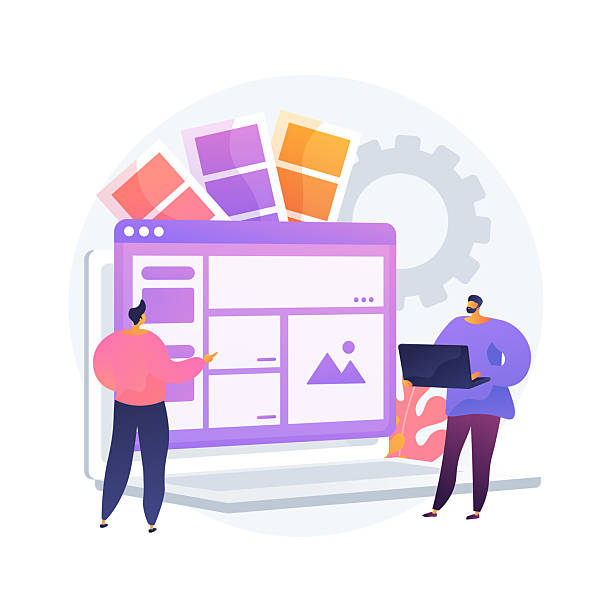
After #professional_e-commerce_website_design, the next step to #increase_sales is to implement effective marketing and advertising strategies.
Even the best site cannot reach its full potential without a strong marketing strategy.
These strategies should drive targeted traffic to your site and convert visitors into customers.
This section provides a guiding and entertaining guide on various marketing methods.
Content marketing, social media marketing, email marketing, Google Ads, and social media advertising (such as Instagram and Facebook) are among the key methods.
Content marketing, by producing blog articles, videos, and guides, helps attract organic traffic and establish your position as an authority in the industry.
Using discounts, seasonal campaigns, and customer loyalty programs can also help increase conversion rates.
Analyzing marketing data to understand customer behavior and optimize campaigns is highly important.
Success in creating an e-commerce site is not just about its appearance, but also about the hidden strategies employed to attract and retain customers.
Table 2: Digital Marketing Strategies for Online Stores
| Strategy Type | Description | Key Benefits |
|---|---|---|
| SEO | Optimizing the site for higher ranking in search results | Free organic traffic, increased credibility |
| Content Marketing | Producing valuable content (blog, video, guides) | Attracting potential customers, increasing brand awareness |
| PPC Advertising (Pay-Per-Click) | Paid advertising on search engines and social media | Fast results, precise budget control |
| Social Media Marketing | Activity and advertising on social platforms | Direct customer interaction, branding |
| Email Marketing | Sending emails to customer and subscriber lists | High return on investment, personalized communication |
Maintenance, Updates, and Security of an Online Store
![]()
After #launching_an_online_store, your work doesn’t end; it’s just beginning.
Regular maintenance and updates are vital actions to maintain the performance, security, and efficiency of an #e-commerce_site.
Neglecting these can lead to security issues, reduced site speed, and ultimately, loss of customers.
This section provides news and descriptive information about the importance of continuous maintenance.
Items such as updating the platform’s core, plugins, and site theme, regular data backups, monitoring site performance and speed, and fixing potential bugs and errors are all part of the maintenance process.
Installing an SSL certificate, using web application firewalls (WAFs), and monitoring suspicious activities are essential for protection against cyberattacks.
E-commerce website design should be done with a long-term approach, and planning for its maintenance and security should be done from the outset.
An up-to-date and secure site not only gains customer trust but also positively impacts search engine rankings.
Did you know that 94% of the first impression of a company is related to its website design?
Rasawweb helps you make the best first impression by providing professional corporate website design services.
✅ Create a professional and trustworthy image of your brand
✅ Easily attract potential customers and improve online positioning
⚡ Get a free corporate website design consultation
Common Mistakes in E-commerce Website Design and How to Avoid Them
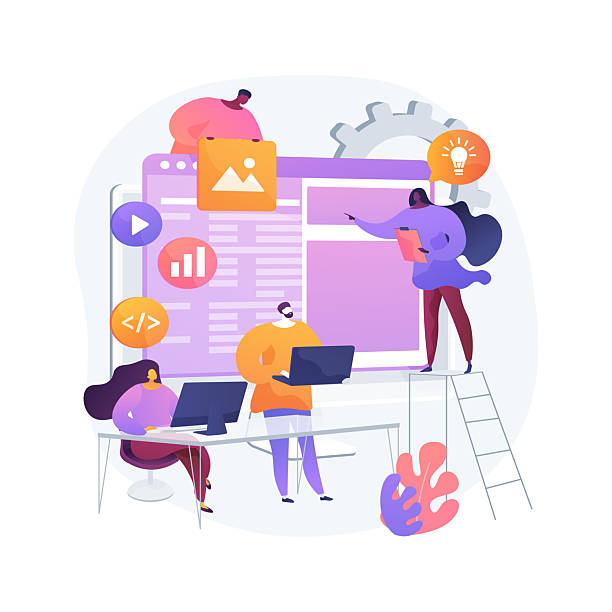
In the #e-commerce_site_development process, there are some #common_mistakes that can lead to the failure of an online business.
Understanding these mistakes and knowing how to avoid them can smooth your path to success.
From complex and cluttered design to neglecting SEO and insufficient security, each can lead to loss of customers and reduced sales.
This section examines the questionable and analytical content of these mistakes.
Among the most common mistakes are lack of mobile optimization, slow page loading speed, confusing navigation, lack of clear contact information, and complex return policies.
Also, neglecting to produce high-quality and unique content, not using attractive product images, and ignoring the customer review section can harm the business.
For successful e-commerce website design, the focus should be on user experience and customer needs.
Meticulous planning, continuous testing, and listening to customer feedback are key to avoiding these mistakes and creating a powerful online platform.
The Future of E-commerce and Emerging Trends in E-commerce Website Design
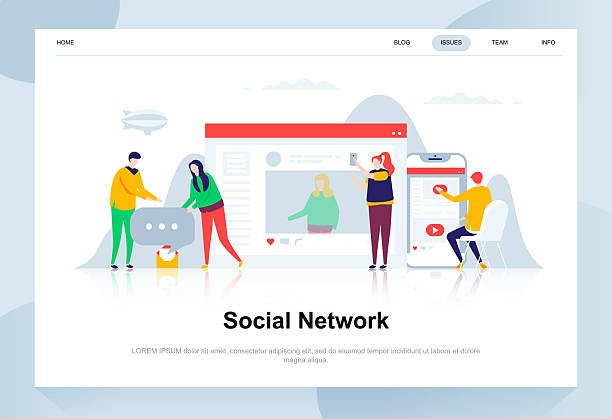
The world of #e-commerce is constantly evolving, and with the emergence of new technologies, the landscape of #e-commerce_website_design is also changing.
Understanding emerging trends is crucial for any business looking to maintain competitiveness and grow in the long term.
From augmented reality (AR) and artificial intelligence (AI) to advanced personalization and voice shopping, the future of online stores looks very exciting.
This section provides news and entertaining perspectives on the future of this field.
Trends such as personalizing the shopping experience using AI and Machine Learning, the possibility of virtual product trials with AR, voice shopping through smart assistants, and the emergence of blockchain to increase transparency and transaction security are examples of the industry’s future.
Also, sustainability and corporate social responsibility have become important factors in customer decision-making.
In future e-commerce website design, attention to these technologies and new customer expectations will lead to the creation of innovative and more engaging shopping experiences.
Companies must be prepared to continuously adapt to these changes to survive and thrive.
Frequently Asked Questions
| Row | Question | Answer |
|---|---|---|
| 1 | What is an e-commerce website? | It is a website that allows the online buying and selling of products or services, enabling users to view, select, and purchase products. |
| 2 | Why do we need e-commerce website design? | With an e-commerce site, businesses can reach a wider audience, operate 24/7, reduce operational costs, and increase sales. |
| 3 | What are the main features of a successful e-commerce website? | Product catalog, shopping cart, secure payment gateway, order management system, user panel, product search and filter capabilities, and responsive design. |
| 4 | What are the common platforms for e-commerce website design? | Common platforms include WordPress (with WooCommerce plugin), Shopify, Magento, PrestaShop, or custom design (coding from scratch). |
| 5 | What is the importance of User Interface (UI) and User Experience (UX) in e-commerce website design? | Proper UI/UX design improves customer experience, reduces bounce rate, increases user time on site, and ultimately boosts conversion rates and sales. |
| 6 | What are the key stages of designing an e-commerce website? | These stages include planning and research, interface and UI design, technical development and coding, content entry, testing and debugging, launch, and support. |
| 7 | What is the importance of security in e-commerce websites? | Security is vital for protecting sensitive user information (such as payment and personal details) and building customer trust. Using SSL certificates and secure payment gateways is essential. |
| 8 | What does SEO mean for an e-commerce website? | It is the optimization of the website for search engines like Google so that product and category pages appear higher in search results and attract more organic (free) traffic. |
| 9 | What is the role of payment gateways in an e-commerce website? | A payment gateway is the link between the customer and the bank that enables secure online financial transactions and transfers money from the customer’s account to the seller’s account. |
| 10 | What does Responsive Design mean in an e-commerce website? | It means that the e-commerce website should display correctly and be easy to use on any device (mobile, tablet, laptop) without losing information or visual distortion. |
And other services of Rasawweb Advertising Agency in the field of advertising
Smart Custom Software: A professional solution for online growth focusing on marketing automation.
Smart Direct Marketing: An effective tool for campaign management with dedicated programming.
Smart Content Strategy: Professional optimization for customer acquisition using user experience customization.
Smart Link Building: Designed for businesses seeking user engagement through user experience customization.
Smart Brand Identity: A dedicated service for growth in increasing sales based on attractive user interface design.
And over hundreds of other services in the field of internet advertising, advertising consultation, and organizational solutions
Internet Advertising | Advertising Strategy | Advertorials
Resources
E-commerce Success Strategies
Comprehensive Guide to Professional E-commerce Website Design
Increase Online Sales with Digital Marketing
Key Tips for Launching a Successful Online Store
? For a leap in the digital world and achieving big goals, Rasawweb Digital Marketing Agency is with you. If you are looking for professional services including personal website design and modern marketing strategies, contact us to take your business to its peak.
📍 Tehran, Mirdamad Street, next to Bank Markazi, Kazerun Jonoubi Alley, Ramin Alley, No. 6

